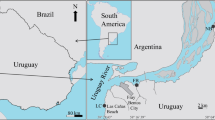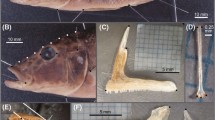Abstract
Relative gut length, Zihler’s index, and relative gut mass were measured in four species of prickleback fishes and the effects of ontogeny, diet, and phylogeny on these gut dimensions were determined. Of the four species, Cebidichthys violaceus and Xiphister mucosus shift to herbivory with growth (>45 mm SL), whereas X. atropurpureus and Anoplarchus purpurescens remain carnivores. A. purpurescens belongs to a carnivorous clade, and the three other species belong to an adjacent, herbivorous clade. Gut dimensions were compared in three feeding categories of the four species: (1) small, wild-caught juveniles representing the carnivorous condition before two species shift to herbivory; (2) larger, wild-caught juveniles representing the natural diet condition of the two carnivores and the two species that have shifted to herbivory; and (3) larger, laboratory-raised juveniles produced by feeding a high-protein artificial diet to small juveniles until they have reached the size of the larger, wild-caught juveniles. Comparisons of gut dimensions in categories (1) versus (2) tested for an ontogenetic effect, in (2) versus (3) for a dietary effect, and within each category for a phylogenetic effect. C. violaceus and X. mucosus increased gut dimensions with increase in body size and did not change ontogenetic trajectory in gut dimensions on the high-protein artificial diet, suggesting that they are genetically programmed to develop relatively large guts associated with herbivory. X. atropurpureus increased its gut dimensions with increase in size similar to its sister taxon, X. mucosus, suggesting a phylogenetic influence, but decreased gut dimensions on the high-protein artificial diet, suggesting phenotypic plasticity. Nevertheless, X. atropurpureus displayed a larger gut than A. purpurescens, further evidence that it evolved in an herbivorous clade. A. purpurescens possessed a relatively small gut that was little affected by ontogeny or diet. Ontogeny and phylogeny more than diet appear to influence gut dimensions in the four species, thus favoring genetic adaptation over phenotypic plasticity as the major force acting on digestive system features in the two prickleback clades.



Similar content being viewed by others
References
Al-Hussaini AH (1947) The feeding habits and the morphology of the alimentary tract of some teleosts living in the neighbourhood of the marine biological station, Ghardaqa, Red Sea. Publ Mar Biol Sta Ghar (Red Sea) 5:1–61
Barton MG (1982) Intertidal vertical distribution and diets of five species of central California stichaeoid fishes. Calif Fish Game 68:174–182
Battley PF, Piersma T (2005) Adaptive interplay between feeding and ecology and features of the digestive tract in birds. In: Starck JM, Wang T (eds) Physiological and ecological adaptations to feeding in vertebrates. Science Publishers Inc., Enfield, pp 201–228
Benavides AG, Cancino JM, Ojeda FP (1994) Ontogenetic changes in gut dimensions and macroalgal digestibility in the marine herbivorous fish, Aplodactylus punctatus. Funct Ecol 8:46–51
Bocanegra A, Nieto A, Blas B, Sanchez-Muniz F (2003) Diets containing a high percentage of Nori or Konbu algae are well-accepted and efficiently utilized by growing rats but induce different degrees of histological changes in the liver and bowel. Food Chem Tox 41:1473–1480
Chan AS, Horn MH, Dickson KA, Gawlicka A (2004) Digestive enzyme activity in carnivores and herbivores: comparisons among four closely related prickleback fishes (Teleostei: Stichaeidae) from a California rocky intertidal habitat. J Fish Biol 65:848–858
Clarke K (1993) Non-parametric multivariate analysis of changes in community structure. Aust J Ecol 18:117–143
Cleveland A, Montgomery WL (2003) Gut characteristics and assimilation efficiencies in two species of herbivorous damselfishes (Pomacentridae: Stegastes dorsopunicans and S. planifrons). Mar Biol 142:35–44
Coleman RM (1992) Reproductive biology and female parental care in the cockscomb prickleback, Anoplarchus purpurescens (Pisces: Stichaeidae). Environ Biol Fish 35:177–186
Cross JN (1981) Structure of a rocky intertidal fish assemblage. PhD Dissertation. University of Washington, Seattle
Drewe KE, Horn MH, Dickson KA, Gawlicka A (2004) Insectivore to frugivore: ontogenetic changes in gut morphology and digestive enzyme activity in the characid fish Brycon guatemalensis from Costa Rican rainforest streams. J Fish Biol 64:890–902
Elliott JP, Bellwood DR (2003) Alimentary tract morphology and diet in three coral reef fish families. J Fish Biol 63:1598–1609
Ellis BA, Mills JN, Kennedy JT, Maiztegui JI, Childs JE (1994) The relationship among diet, alimentary tract morphology, and life history for five species of rodents from the central Argentine pampa. Acta Theriol 39:345–355
Eschmeyer WN, Herald ES, Hammann H (1983) A field guide to Pacific coast fishes of North America. Houghton Mifflin Co., Boston
Follett WI, Anderson ME (1990) Esalenia, a new genus of pricklebacks (Teleostei: Stichaeidae), with two new species from California and Baja California Norte. Copeia 1990:147–163
Fris MB, Horn MH (1993) Effects of diets of different protein content on food consumption, gut retention, protein conversion, and growth of Cebidichthys violaceus (Girard), an herbivorous fish of temperate zone marine waters. J Exp Mar Biol Ecol 166:185–202
Frierson EW, Foltz JW (1992) Comparison and estimation of absorptive intestinal surface areas in two species of cichlid fish. Trans Am Fish Soc 121:517–523
Fuentes LS, Cancino JM (1990) Cambios morfometricos en el tubo digestivo de juveniles de Girella laevifrons (Kyphosidae) en funcion de la dieta y del nivel de replecion. Rev Biol Mar Val 25:19–26
Gallagher ML, Luczkovich JJ, Stellwag EJ (2001) Characterization of the ultrastructure of the gastrointestinal tract mucosa, stomach contents and liver enzyme activity of the pinfish during development. J Fish Biol 58:1704–1713
Gawlicka A, Horn MH (2005) Storage and absorption in the digestive system of carnivorous and herbivorous prickleback fishes (Teleostei: Stichaeidae): ontogenetic, dietary, and phylogenetic effects. Physiol Biochem Zool 78:879–892
German DP, Horn MH, Gawlicka A (2004) Digestive enzyme activities in herbivorous and carnivorous prickleback fishes (Teleostei: Stichaeidae): ontogenetic, dietary, and phylogenetic effects. Physiol Biochem Zool 77:789–804
Horn MH (1989) Biology of marine herbivorous fishes. Oceanogr Mar Biol Annu Rev 27:167–272
Horn MH, Gawlicka A, German DP, Logothetis EA, Cavanagh JW, Boyle KS (2005) Structure and function of the stomachless digestive system in three related species of New World silverside fishes (Atherinopsidae) representing herbivory, omnivory, and carnivory. Mar Biol (in revision)
Horn MH, Murray SN, Edwards TW (1982) Dietary selectivity in the field and food preferences in the laboratory for two herbivorous fishes (Cebidichthys violaceus and Xiphister mucosus) from a temperate intertidal zone. Mar Biol 67:237–246
Horn MH, Murray SN, Seapy RR (1983) Seasonal structure of a central California rocky intertidal community in relation to environmental variations. Bull South Cal Acad Sci 82:79–94
Horn MH, Ojeda FP (1999) Herbivory. In: Horn MH, Martin KLM, Chotkowski MA (eds) Intertidal fishes: life in two worlds. Academic, San Diego, pp 197–222
Jones JA (1981) Competition for substrates in laboratory experiments between Anoplarchus purpurescens (Pisces, Stichaeidae) and three related species from the central California rocky intertidal zone. MA Thesis, California State University, Fullerton
Jones RS (1968) A suggested method for quantifying gut contents in herbivorous fishes. Micronesica 4:369–371
Kapoor BG, Smit H, Verighina IA (1975) The alimentary canal and digestion in teleosts. Adv Mar Biol 13:109–239
King PA, Fives JM, McGrath D (1994) Reproduction, growth, and feeding of the dragonet Callionymus lyra (Teleostei: Callionymidae), in Galway Bay, Ireland. J Mar Biol Assoc UK 74:513–526
Korn H (1992) Intestine lengths of Southern African savanna rodents and insectivores: intra- and interspecific comparisons. J Zool 228:455–460
Kramer DL, Bryant MJ (1995a) Intestine length in the fishes of a tropical stream: 1. Ontogenetic allometry. Environ Biol Fish 42:115–127
Kramer DL, Bryant MJ (1995b) Intestine length in the fishes of a tropical stream: 2. Relationships to diet—the long and the short of a convoluted issue. Environ Biol Fish 42:129–141
Lehtonen KK (1996) Ecophysiology of the benthic amphipod Monoporeia affinis in an open-sea area of the northern Baltic Sea: seasonal variations in body composition, with bioenergetic considerations. Mar Ecol Prog Ser 143:87–98
Lemos D, Phan VN (2001) Ontogenetic variation in metabolism, biochemical composition and energy content during the early life stages of Farfantepenaeus paulensis (Crustacea: Decapoda: Penaeidae). Mar Biol 138:985–997
Lloret J, Planes S (2003) Condition, feeding, and reproductive potential of white seabream Diplodus sargus as indicators of habitat quality and the effect of reserve protection in the northwest Mediterranean. Mar Ecol Prog Ser 248:197–208
Logothetis EA, Horn MH, Dickson KA (2001) Gut morphology and function in Atherinops affinis (Teleostei: Atherinopsidae), a stomachless omnivore feeding on macroalgae. J Fish Biol 59:1298–1312
Marshall WH, Echeverria TW (1992) Age, length, weight, reproductive cycle and fecundity of the monkeyface prickleback (Cebidichthys violaceus). Calif Fish Game 78:57–64
Montgomery WL (1977) Diet and gut morphology in fishes with special reference to the monkeyface prickleback, Cebidichthys violaceus (Stichaeidae: Blennioidei). Copeia 1997:178–182
Ribble DO, Smith MH (1983) Relative intestine length and feeding ecology of freshwater fishes. Growth 47:292–300
Ricklefs RE (1996) Morphometry of digestive tracts of some passerine birds. Condor 98:279–292
Sabat P, Lagos JA, Bozinovic F (1999) Test of the adaptive modulation hypothesis in rodents: dietary flexibility and enzyme plasticity. Comp Biochem Physiol A 123:83–87
Setran AC, Behrens DW (1993) Transitional ecological requirements for early juveniles of two sympatric stichaeid fishes, Cebidichthys violaceus and Xiphister mucosus. Environ Biol Fish 37:381–395
Sibley RM, Calow P (1986) Physiological ecology of animals, an evolutionary approach. Blackwell, Oxford
Smith DR (2002) Trophic position of estuarine and kelp-bed populations of the omnivorous silverside fish Atherinops affinis (Teleostei: Atherinopsidae) from southern California: analyses of dietary items and 15N and 13C stable isotopes. MS Thesis, California State University, Fullerton
Starck JM (1999) Phenotypic flexibility in the avian gizzard: rapid, reversible, and repeated changes of organ size in response to changes in dietary fiber content. J Exp Biol 202:3171–3179
Starck JM (2005) Structural flexibility of the digestive system of tetrapods: patterns and processes at the cellular and tissue level. In: Starck JM, Wang T (eds) Physiological and ecological adaptations to feeding in vertebrates. Science Publishers Inc., Enfield, pp 175–200
Stevens CE, Hume ID (1995) Comparative physiology of the vertebrate digestive system. Press Syndicate, University of Cambridge, Melbourne
Stoddard KM (1985) A phylogenetic analysis of some prickleback fishes (Teleostei, Stichaeidae, Xiphisterinae) from the north Pacific Ocean, with a discussion of their biogeography. MA Thesis, California State University, Fullerton
Stoner A, Livingston R (1984) Ontogenetic patterns in diet and feeding morphology in sympatric sparid fishes from seagrass meadows. Copeia, pp 174–187
Toloza EM, Diamond J (1990) Ontogenetic development of transporter regulation in bullfrog intestine. Am J Physiol 258:G770–G773
White TCR (1985) When is a herbivore not a herbivore? Oecologia 67:596–597
Wingert RC (1974) Comparative reproductive cycles and growth histories of two species of Xiphister (Pisces: Stichaeidae) from San Simeon, California. MA Thesis, California State University, Fullerton
Wong K, Cheung P (2000) Nutritional evaluation of some subtropical red and green seaweeds. Part I: proximate composition, amino acid profiles, and some physico-chemical properties. Food Chem 71:475–482
Zihler F (1982) Gross morphology and configuration of digestive tracts of Cichlidae (Teleostei: Perciformes): phylogenetic and functional significance. Neth J Zool 32:544–571
Acknowledgements
We thank A. Gawlicka for help in the organizational phases of the study and in the field and laboratory, K. Boyle, M. Saba, K. Kim, E. Cox, and S. Choi for assistance in the field and laboratory, J. Carroll for providing access to Diablo Canyon and helping to collect X. mucosus , J. Degan for help in constructing the tank supports, K. Drewe for discussions on gut morphology, D. Smith for statistical insights and L. Crummett for moral support. Financial support was provided by a grant (OCE-9906857) from the National Science Foundation (M. H. Horn, principal investigator), a Sigma Xi Grant-in-Aid of Research and by the Departmental Associations Council and Department of Biological Science at California State University, Fullerton.
Author information
Authors and Affiliations
Corresponding author
Additional information
Communicated by P.W. Sammarco, Chauvin
Rights and permissions
About this article
Cite this article
German, D.P., Horn, M.H. Gut length and mass in herbivorous and carnivorous prickleback fishes (Teleostei: Stichaeidae): ontogenetic, dietary, and phylogenetic effects. Marine Biology 148, 1123–1134 (2006). https://doi.org/10.1007/s00227-005-0149-4
Received:
Accepted:
Published:
Issue Date:
DOI: https://doi.org/10.1007/s00227-005-0149-4




